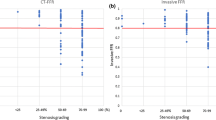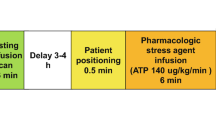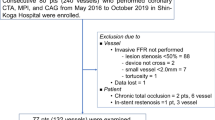Abstract
Although single photon emission computed tomography-myocardial perfusion image (SPECT-MPI) and fractional flow reserve (FFR) derived from coronary computed tomographic angiography (CCTA) (FFRCT) have permitted functional assessment of coronary artery disease (CAD), the concordance between these modalities has not been well described. The aim of this study is to compare SPECT-MPI and anatomical stenosis by CCTA and invasive coronary angiography to FFRCT for assessing functional significance of CAD. We identified 62 patients with suspected CAD who underwent ≥64 slice coronary CTA and SPECT-MPI within 3 months. FFRCT was analyzed from CCTA data using the computational fluid dynamic techniques. The association between SPECT-MPI ischemia and FFRCT (≤0.80) was evaluated. Out of 62 patients, 186 vessels were evaluated. On a per-vessel analysis, accuracy, sensitivity and specificity of SPECT-MPI to predict FFRCT ≤ 0.80 was 74.2, 45.0 and 77.7%, respectively. The area under the curve (AUC) by receiver-operating characteristic curve analysis for SPECT-MPI demonstrated a modest performance for predicting FFRCT ≤ 0.80 (AUC 0.56). Among patients with suspected CAD who were assessed by non-invasive functional modalities, SPECT-MPI showed modest concordance with FFRCT.

Similar content being viewed by others
References
Berman DS, Kang X, Slomka PJ, Gerlach J, de Yang L, Hayes SW, Friedman JD, Thomson LE, Germano G (2007) Underestimation of extent of ischemia by gated SPECT myocardial perfusion imaging in patients with left main coronary artery disease. J Nucl Cardiol 14:521–528
Nakanishi R, Gransar H, Slomka P, Arsanjani R, Shalev A, Otaki Y, Friedman JD, Hayes SW, Thomson LE, Fish M, Germano G, Abidov A, Shaw L, Rozanski A, Berman DS (2016) Predictors of high-risk coronary artery disease in subjects with normal SPECT myocardial perfusion imaging. J Nucl Cardiol 23:530–541
Melikian N, De Bondt P, Tonino P, De Winter O, Wyffels E, Bartunek J, Heyndrickx GR, Fearon WF, Pijls NH, Wijns W, De Bruyne B (2010) Fractional flow reserve and myocardial perfusion imaging in patients with angiographic multivessel coronary artery disease. JACC Cardiovasc Interv 3:307–314
Patel MR, Dai D, Hernandez AF, Douglas PS, Messenger J, Garratt KN, Maddox TM, Peterson ED, Roe MT (2014) Prevalence and predictors of nonobstructive coronary artery disease identified with coronary angiography in contemporary clinical practice. Am Heart J 167:846–52.e2
Neglia D, Rovai D, Caselli C, Pietila M, Teresinska A, Aguade-Bruix S, Pizzi MN, Todiere G, Gimelli A, Schroeder S, Drosch T, Poddighe R, Casolo G, Anagnostopoulos C, Pugliese F, Rouzet F, Le Guludec D, Cappelli F, Valente S, Gensini GF, Zawaideh C, Capitanio S, Sambuceti G, Marsico F, Perrone Filardi P, Fernandez-Golfin C, Rincon LM, Graner FP, de Graaf MA, Fiechter M, Stehli J, Gaemperli O, Reyes E, Nkomo S, Maki M, Lorenzoni V, Turchetti G, Carpeggiani C, Marinelli M, Puzzuoli S, Mangione M, Marcheschi P, Mariani F, Giannessi D, Nekolla S, Lombardi M, Sicari R, Scholte AJ, Zamorano JL, Kaufmann PA, Underwood SR, Knuuti J (2015) Detection of significant coronary artery disease by noninvasive anatomical and functional imaging. Circulation. doi:10.1161/CIRCIMAGING.114.002179
Koo BK, Erglis A, Doh JH, Daniels DV, Jegere S, Kim HS, Dunning A, DeFrance T, Lansky A, Leipsic J, Min JK (2011) Diagnosis of ischemia-causing coronary stenoses by noninvasive fractional flow reserve computed from coronary computed tomographic angiograms. Results from the prospective multicenter DISCOVER-FLOW (diagnosis of ischemia-causing stenoses obtained via noninvasive fractional flow reserve) study. J Am Coll Cardiol 58:1989–1997
Min JK, Leipsic J, Pencina MJ, Berman DS, Koo BK, van Mieghem C, Erglis A, Lin FY, Dunning AM, Apruzzese P, Budoff MJ, Cole JH, Jaffer FA, Leon MB, Malpeso J, Mancini GB, Park SJ, Schwartz RS, Shaw LJ, Mauri L (2012) Diagnostic accuracy of fractional flow reserve from anatomic CT angiography. JAMA 308:1237–1245
Norgaard BL, Leipsic J, Gaur S, Seneviratne S, Ko BS, Ito H, Jensen JM, Mauri L, De Bruyne B, Bezerra H, Osawa K, Marwan M, Naber C, Erglis A, Park SJ, Christiansen EH, Kaltoft A, Lassen JF, Botker HE, Achenbach S (2014) Diagnostic performance of noninvasive fractional flow reserve derived from coronary computed tomography angiography in suspected coronary artery disease: the NXT trial (analysis of coronary blood flow using CT angiography: next steps). J Am Coll Cardiol 63:1145–1155
Norgaard BL, Jensen JM, Leipsic J (2015) Fractional flow reserve derived from coronary CT angiography in stable coronary disease: a new standard in non-invasive testing? Eur Radiol 25:2282–2290
Budoff MJ, Dowe D, Jollis JG, Gitter M, Sutherland J, Halamert E, Scherer M, Bellinger R, Martin A, Benton R, Delago A, Min JK (2008) Diagnostic performance of 64-multidetector row coronary computed tomographic angiography for evaluation of coronary artery stenosis in individuals without known coronary artery disease: results from the prospective multicenter ACCURACY (assessment by coronary computed tomographic angiography of individuals undergoing invasive coronary angiography) trial. J Am Coll Cardiol 52:1724–1732
Budoff MJ, Kalia N, Cole J, Nakanishi R, Nezarat N, Thomas JL (2017) Diagnostic accuracy of Visipaque enhanced coronary computed tomographic angiography: a prospective multicenter trial. Coron Artery Dis 28:52–56
Taylor CA, Fonte TA, Min JK (2013) Computational fluid dynamics applied to cardiac computed tomography for noninvasive quantification of fractional flow reserve: scientific basis. J Am Coll Cardiol 61:2233–2241
Tanaka H, Takahashi T, Kozono N, Tanakamaru Y, Ohashi N, Yasunobu Y, Tanaka K, Okada T, Kaseda S, Nakanishi T, Kihara Y (2016) Prediction of flow-limiting fractional flow reserve in patients with stable coronary artery disease based on quantitative myocardial perfusion imaging. Am J Cardiol 117:1417–1426
Sahiner I, Akdemir UO, Kocaman SA, Sahinarslan A, Timurkaynak T, Unlu M (2013) Quantitative evaluation improves specificity of myocardial perfusion SPECT in the assessment of functionally significant intermediate coronary artery stenoses: a comparative study with fractional flow reserve measurements. Ann Nucl Med 27:132–139
Forster S, Rieber J, Ubleis C, Weiss M, Bartenstein P, Cumming P, Klauss V, Hacker M (2010) Tc-99m sestamibi single photon emission computed tomography for guiding percutaneous coronary intervention in patients with multivessel disease: a comparison with quantitative coronary angiography and fractional flow reserve. Int J Cardiovasc Imaging 26:203–213
Ragosta M, Bishop AH, Lipson LC, Watson DD, Gimple LW, Sarembock IJ, Powers ER (2007) Comparison between angiography and fractional flow reserve versus single-photon emission computed tomographic myocardial perfusion imaging for determining lesion significance in patients with multivessel coronary disease. Am J Cardiol 99:896–902
Hacker M, Rieber J, Schmid R, Lafougere C, Tausig A, Theisen K, Klaus V, Tiling R (2005) Comparison of Tc-99m sestamibi SPECT with fractional flow reserve in patients with intermediate coronary artery stenoses. J Nucl Cardiol 12:645–654
Chamuleau SA, Meuwissen M, van Eck-Smit BL, Koch KT, de Jong A, de Winter RJ, Schotborgh CE, Bax M, Verberne HJ, Tijssen JG, Piek JJ (2001) Fractional flow reserve, absolute and relative coronary blood flow velocity reserve in relation to the results of technetium-99m sestamibi single-photon emission computed tomography in patients with two-vessel coronary artery disease. J Am Coll Cardiol 37:1316–1322
Douglas PS, Pontone G, Hlatky MA, Patel MR, Norgaard BL, Byrne RA, Curzen N, Purcell I, Gutberlet M, Rioufol G, Hink U, Schuchlenz HW, Feuchtner G, Gilard M, Andreini D, Jensen JM, Hadamitzky M, Chiswell K, Cyr D, Wilk A, Wang F, Rogers C, De Bruyne B (2015) Clinical outcomes of fractional flow reserve by computed tomographic angiography-guided diagnostic strategies vs. usual care in patients with suspected coronary artery disease: the prospective longitudinal trial of FFRCT: outcome and resource impacts study. Eur Heart J 36:3359–3367
Norgaard BL, Hjort J, Gaur S, Hansson N, Botker HE, Leipsic J, Mathiassen ON, Grove EL, Pedersen K, Christiansen EH, Kaltoft A, Gormsen LC, Maeng M, Terkelsen CJ, Kristensen SD, Krusell LR, Jensen JM (2017) Clinical use of coronary CTA-derived FFR for decision-making in stable CAD. JACC Cardiovasc Imaging 10:541–550
Dattilo PB, Prasad A, Honeycutt E, Wang TY, Messenger JC (2012) Contemporary patterns of fractional flow reserve and intravascular ultrasound use among patients undergoing percutaneous coronary intervention in the United States: insights from the National Cardiovascular Data Registry. J Am Coll Cardiol 60:2337–2339
Tonino PA, De Bruyne B, Pijls NH, Siebert U, Ikeno F, van’ t Veer M, Klauss V, Manoharan G, Engstrom T, Oldroyd KG, Ver Lee PN, MacCarthy PA, Fearon WF (2009) Fractional flow reserve versus angiography for guiding percutaneous coronary intervention. N Engl J Med 360:213–224
Vavalle JP, Shen L, Broderick S, Shaw LK, Douglas PS (2016) Effect of the presence and type of angina on cardiovascular events in patients without known coronary artery disease referred for elective coronary angiography. JAMA Cardiol 1:232–234
Curzen NP, Nolan J, Zaman AG, Norgaard BL, Rajani R (2016) Does the routine availability of CT-derived FFR influence management of patients with stable chest pain compared to CT angiography alone?: The FFRCT RIPCORD study. JACC Cardiovasc Imaging 9:1188–1194
Hachamovitch R, Hayes SW, Friedman JD, Cohen I, Berman DS (2003) Comparison of the short-term survival benefit associated with revascularization compared with medical therapy in patients with no prior coronary artery disease undergoing stress myocardial perfusion single photon emission computed tomography. Circulation 107:2900–2907
Shaw LJ, Berman DS, Maron DJ, Mancini GB, Hayes SW, Hartigan PM, Weintraub WS, O’Rourke RA, Dada M, Spertus JA, Chaitman BR, Friedman J, Slomka P, Heller GV, Germano G, Gosselin G, Berger P, Kostuk WJ, Schwartz RG, Knudtson M, Veledar E, Bates ER, McCallister B, Teo KK, Boden WE (2008) Optimal medical therapy with or without percutaneous coronary intervention to reduce ischemic burden: results from the clinical outcomes utilizing revascularization and aggressive drug evaluation (COURAGE) trial nuclear substudy. Circulation 117:1283–1291
Berman DS, Min JK (2009) Can coronary computed tomographic angiography trigger coronary revascularization? Questioning the appropriateness of the question. JACC Cardiovasc Interv 2:558–560
Sarno G, Decraemer I, Vanhoenacker PK, De Bruyne B, Hamilos M, Cuisset T, Wyffels E, Bartunek J, Heyndrickx GR, Wijns W (2009) On the inappropriateness of noninvasive multidetector computed tomography coronary angiography to trigger coronary revascularization: a comparison with invasive angiography. JACC Cardiovasc Interv 2:550–557
Acknowledgements
Dr. Campbell Rogers and Mr. Souma Gupta are full time employees of HeartFlow, with salary and equity from HeartFlow.
Author information
Authors and Affiliations
Corresponding author
Ethics declarations
Conflict of interest
Unrestricted money as grant support to institution to do independent research from HeartFlow. The other authors have no conflict of interest.
Rights and permissions
About this article
Cite this article
Nakanishi, R., Osawa, K., Ceponiene, I. et al. The diagnostic performance of SPECT-MPI to predict functional significant coronary artery disease by fractional flow reserve derived from CCTA (FFRCT): sub-analysis from ACCURACY and VCT001 studies. Int J Cardiovasc Imaging 33, 2067–2072 (2017). https://doi.org/10.1007/s10554-017-1207-y
Received:
Accepted:
Published:
Issue Date:
DOI: https://doi.org/10.1007/s10554-017-1207-y




